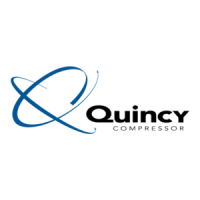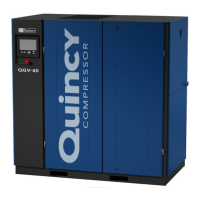Do you have a question about the Quincy Compressor QSI 1500 and is the answer not in the manual?
Outlines the warranty terms and conditions for the compressor.
Explains hazard symbols used throughout the manual to denote danger levels.
Provides essential safety guidelines for operating and maintaining the compressor.
Details how the compressor regulates its output based on demand.
Outlines the electrical components, power supply, and wiring of the compressor.
Explains the function and importance of high air temperature (HAT) sensors.
Specifies the ideal environmental conditions and space requirements for compressor placement.
Explains the proper installation and function of pressure relief valves for system safety.
Lists essential checks and preparations required before starting the compressor.
Step-by-step instructions for safely starting the compressor.
Procedures for normally and emergently stopping the compressor.
Identifies and explains the functions of the control panel components and indicators.
Step-by-step guide to accessing the main menu and its sub-items.
Accessing the service menu to manage maintenance plans and intervals.
Key procedures to follow for safe preparation before maintenance or service.
General safety precautions to be observed by service personnel.
Lists recommended synthetic fluids and their properties for Quincy compressors.
Details Quincy's fluid analysis service and its importance for warranty.
Lists common causes and corrective actions for the compressor failing to start.
Addresses issues causing unexpected shutdowns and their solutions.
Explains why thermal overload relays trip and how to address it.
Identifies causes for reduced air output and their solutions.
Addresses causes for low receiver pressure and their remedies.
Discusses causes for high receiver pressure and how to resolve them.
Explains causes of high discharge air temperature and corrective actions.
Addresses frequent clogging of the air/fluid separator and its causes.
Identifies causes for frequent fluid filter clogging and solutions.
Continues troubleshooting for separator clogging, including fluid issues.
Addresses issues related to the fluid discharge blowdown valve.
Explains causes of excessive fluid consumption and how to fix them.
Addresses frequent clogging of the air cleaner and potential causes.
Guides on resolving issues with inlet valve operation related to air demand.
Addresses why the compressor might not unload when there is no air demand.
Solutions for when the compressor fails to reload after pressure drops.
Addresses issues with the auto/dual timer not shutting down unloaded compressors.
Solutions for excessive water in the plant air distribution system.
Discusses causes of pressure relief valve exhausting and their remedies.
Identifies causes for excessive water in compressor fluid and solutions.
Provides a schedule for routine maintenance tasks based on time intervals.
Outlines the warranty terms and conditions for the compressor.
Explains hazard symbols used throughout the manual to denote danger levels.
Provides essential safety guidelines for operating and maintaining the compressor.
Details how the compressor regulates its output based on demand.
Outlines the electrical components, power supply, and wiring of the compressor.
Explains the function and importance of high air temperature (HAT) sensors.
Specifies the ideal environmental conditions and space requirements for compressor placement.
Explains the proper installation and function of pressure relief valves for system safety.
Lists essential checks and preparations required before starting the compressor.
Step-by-step instructions for safely starting the compressor.
Procedures for normally and emergently stopping the compressor.
Identifies and explains the functions of the control panel components and indicators.
Step-by-step guide to accessing the main menu and its sub-items.
Accessing the service menu to manage maintenance plans and intervals.
Key procedures to follow for safe preparation before maintenance or service.
General safety precautions to be observed by service personnel.
Lists recommended synthetic fluids and their properties for Quincy compressors.
Details Quincy's fluid analysis service and its importance for warranty.
Lists common causes and corrective actions for the compressor failing to start.
Addresses issues causing unexpected shutdowns and their solutions.
Explains why thermal overload relays trip and how to address it.
Identifies causes for reduced air output and their solutions.
Addresses causes for low receiver pressure and their remedies.
Discusses causes for high receiver pressure and how to resolve them.
Explains causes of high discharge air temperature and corrective actions.
Addresses frequent clogging of the air/fluid separator and its causes.
Identifies causes for frequent fluid filter clogging and solutions.
Continues troubleshooting for separator clogging, including fluid issues.
Addresses issues related to the fluid discharge blowdown valve.
Explains causes of excessive fluid consumption and how to fix them.
Addresses frequent clogging of the air cleaner and potential causes.
Guides on resolving issues with inlet valve operation related to air demand.
Addresses why the compressor might not unload when there is no air demand.
Solutions for when the compressor fails to reload after pressure drops.
Addresses issues with the auto/dual timer not shutting down unloaded compressors.
Solutions for excessive water in the plant air distribution system.
Discusses causes of pressure relief valve exhausting and their remedies.
Identifies causes for excessive water in compressor fluid and solutions.
Provides a schedule for routine maintenance tasks based on time intervals.
| Model | QSI 1500 |
|---|---|
| Type | Rotary Screw |
| Horsepower | 150 HP |
| Phase | 3 |
| Maximum Pressure | 150 PSIG |
| Frequency | 60 Hz |
| Number of Stages | Single |
| Drive Type | Direct |
| Cooling Method | Air-Cooled |
| Lubrication Type | Oil-Lubricated |












